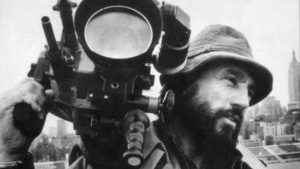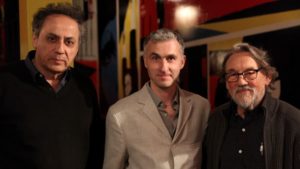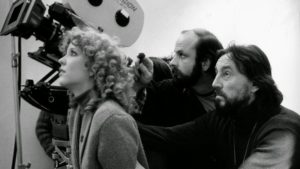With equal amounts of artistic intrigue and a dissemination of vital filmmaking crafts, French director Pierre Filmon’s new feature explores the career of cinematographer Vilmos Zsigmond (1930–2016). Created when Zsigmond was still alive, Close Encounters with Vilmos Zsigmond examines the director of photography’s illustrious work and features many of his most notable films.

Being a true cinephile, Filmon had long known about Zsigmond, a native of Hungary. “Actually, he was a hero of mine,” Filmon said. “I always was struck by cinematography, looking at the screen in any film I watched and looking up the name of the cinematographer. Vilmos Zsigmond was back in my head for many years before I had the chance to meet him.”
As a self-professed late bloomer to film appreciation, Filmon hailed from a distant part of Paris, where, in his province, there was only one cinema, mandating that he first viewed movies via television airings. “Then, in my late twenties, I discovered cinema,” Filmon recalled. “From that moment on, I never quit. I discovered Vilmos’ films and all the great classical movies when I came to Paris in the 1990s.”
In his research, Filmon came across the American production, Visions of Light, which documents the history of cinematography, and James Chressanthis’ film No Subtitles Necessary, about the relationship between Zsigmond and Laszlo Kovacs, another great Hungarian cinematographer. Through a friendship with French-Iranian cinematographer Darius Khondji, for whom Zsigmond was a godfather when he entered the American Society of Cinematographers (ASC), Filmon first got in contact with Zsigmond in August of 2012.
Significantly, the following month, Filmon organized an evening at the cinema with Zsigmond and screenings of the latter’s films Heaven’s Gate and Deliverance. On the day of the special evening, October 12, over a dinner, Filmon told Zsigmond, in lieu of a planned dramatic film project, “I must make a film about you,” and Zsigmond immediately agreed. “Having his consent was like, ‘Okay, let’s do this. I don’t know how I will get the money, or who I would get in this film, but let’s do it.’”

Soon, Filmon learned that at the May, 2013 Cannes Film Festival, Zsigmond was to be the recipient of a special recognition, an oddity for Cannes which typically does not issue awards for craftspeople. “Vilmos was invited for a week in Cannes,” Filmon stated, “and he was coming to Paris for some time with his wife. So, I told him, ‘Let’s start the filming there.’ I organized for Vilmos a retrospective of 15 of his films and started to film him in a very simple way—just interviewing him in the cinema.”
With the price of licensing numerous film clips being prohibitive for Close Encounters with Vilmos Zsigmond, Filmon instead focused on Zsigmond, the human being. To that point, in the middle of editing in July 2015, Filmon had a first rough cut of his film, albeit with no film clips of Zgimond’s work. “I had the chance to meet a French post-production supervisor who had the chance to see it in an early phase,” Filmon explained of his film. “He says, ‘I’ve discovered this amazing thing called ‘fair use.’ He explained how you can use a piece of pre-existing material for free—if you’re careful. He gave me the number of a lawyer in the U.S. who’s a specialist in dealing with fair use — it, literally, saved the film.”
Inserting clips from Zsigmond’s most notable motion pictures, Filmon nonetheless had to re-edit the film three times before he was given full clearance. “With fair use, you have to use a smaller amount of a big piece of art,” Filmon divulged. “When we are dealing with a film like Heaven’s Gate, which is nearly four hours, if you use 10 seconds, it’s a very low percentage of the huge work of art. The problem arose with [Steven] Spielberg’s Close Encounters; if you want to use the music, it’s a problem, because, as soon as you recognize the theme of the music, it’s no longer fair use.”
As the production came to California for principal photography just once, Chressanthis volunteered to serve as the cinematographer for scenes shot at the famed ASC Clubhouse. “He opened gates for me that otherwise might have been closed,” said Filmon of Chressanthis, “and Vilmos was instrumental to gather his friends at the ASC. Without Vilmos and James, I wouldn’t have been able to do anything in the U.S..”

While Filmon finished his film in January 2016, he called Zsigmond, but his wife informed Filmon that Zsigmond had just died. “I was struck, as I felt very close to him for two years,” revealed Filmon. “I always said [during] shooting, ‘You’re going to bury us all.’ I had such a strong respect for him that it didn’t cross my mind that he was mortal. For me, he was immortal.”
Directly following Zsigmond’s passing, Filmon watched his documentary again. “Vilmos was there, alive,” he said, hauntingly. “It was very strange that, even though I knew he passed away, I couldn’t believe it, because he was in front of my eyes.”
In 2016, Filmon took his project to the Cannes Film Festival as an Official Selection; it was thereafter released in France and Hungary, Zsigmond’s homeland. “Once this film was successful in France, one of the great cinematographers asked me what’s next,” Filmon related in spring of 2020. “I said, ‘I don’t know, but I still have a great relationship with Vittorio Storaro, the great cinematographer of Apocalypse Now. He’s still alive—I was with him two weeks ago; we had lunch, but he was a bit reluctant. I organized the first exhibition of his photos in France three weeks before the virus came. For the time being, I’m not sure about the subject of my next documentary. I want to find the right subject—I still have this Vilmos film inside me very deeply.”
You can learn more about Close Encounters with Vilmos Szigmond here, and about director Pierre Filmon at his own site.





